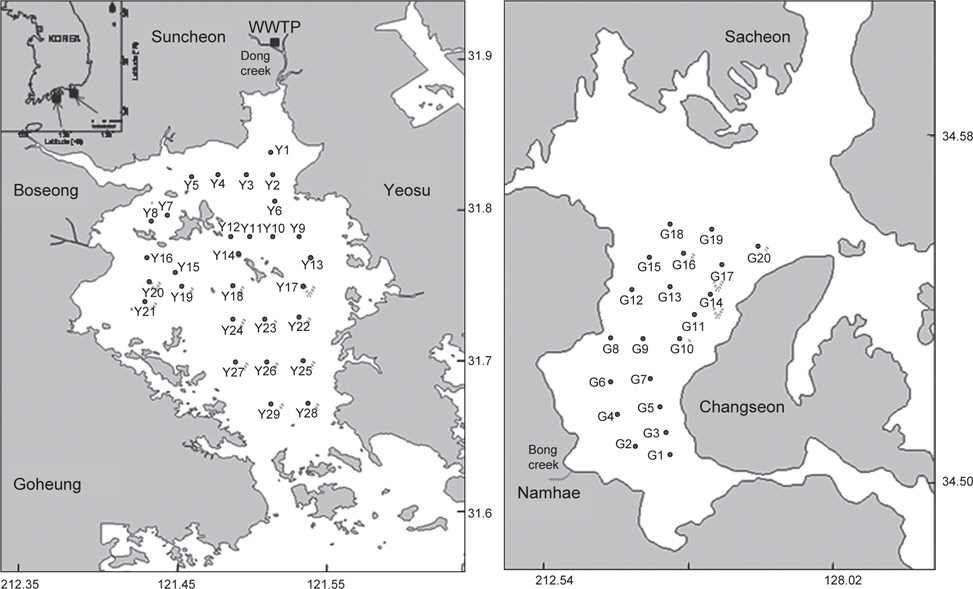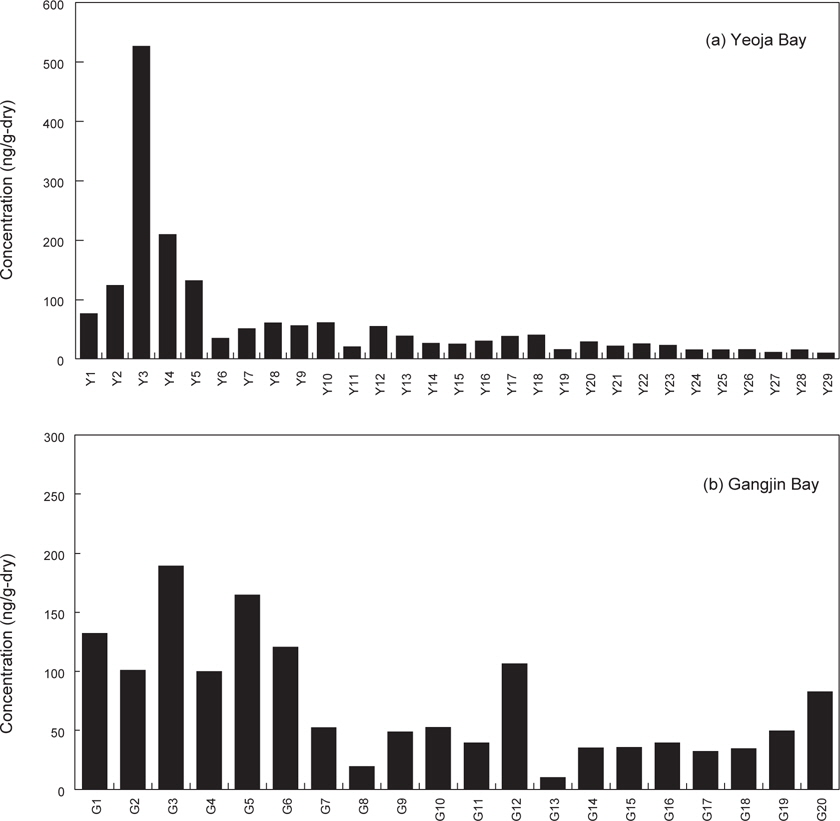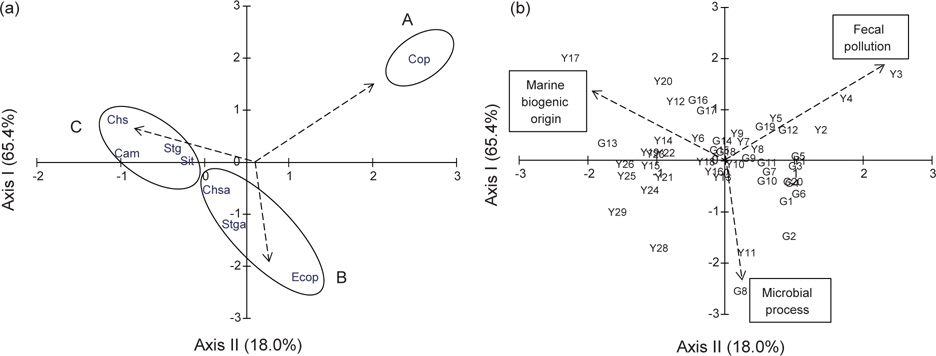



Eight fecal sterols were analyzed in surface sediments collected from shellfish farming areas in Yeoja Bay and Gangjin Bay, Korea, to evaluate sewage-derived fecal pollution. The concentrations of coprostanol, a good marker of sewage-derived organic contamination, in sediments were in the range of 10-530 ng/g-dry in Yeoja Bay, and 10-190 ng/g-dry in Gangjin Bay. Coprostanol levels were markedly higher in the inner bay than in the outer bay. These levels were lower than those reported in urbanized bays in Korea, however, they were comparable to levels in other shellfish farming areas including Gamak Bay. A multivariate analysis of the ratios of other sterols suggested that the sterols originated from sewage and plankton/benthos. Sewage was the dominant source at stations located close to the river mouth and wastewater treatment plant (WWTP) outfalls, and plankton/benthos was the primary source in the outer bay. These results suggest that management of point sources, e.g., WWTP as well as non-point sources, e.g., riverine inputs is important for improving the water quality in Yeoja Bay and Gangjin Bay.
여자만은 남해안 중앙에 위치하고 있으며, 고흥반도와 여수반도로 둘러싸여 있는 반 폐쇄성 내만으로 평균수심은 약 5.4 m, 남북길이는 30 km, 동서길이는 22 km에 달한다(Fig. 1). 여자만은 남해안의 다른 만들에 비해 면적이 넓은 반면 외해수와의 교환은 남쪽 만 입구의 좁은 수로를 통해서 이루어 진다. 여자만에 허가된 양식면허는 465건, 7,056 ha이며, 주요 생산품종은 피조개, 고막과 새고막이고, 고막류의 면허는 351건, 4,712 ha로 전체 양식면의 67%를 차지한다(Lee, 2012). 남해 강진만은 경상남도의 남서부에 남해군, 사천시, 하동군에 의해 둘러싸여 있는 반폐쇄성 내만으로 평균수심은 약 3.6 m, 남북길이 약 18 km, 동서길이 약 15 km에 달한다(Fig. 1). 강진만은 총 168건에 1,028 ha의 어업권이 허가되어 있고, 양식어업은 피조개 양식(109건, 623 ha)이 가장 많고, 바지락(27건, 202 ha), 굴(25건, 147 ha), 새고막(7건, 55ha)순이었다. 강진만 해면중 5,290 ha는 수출용 패류생산해역(7호 해역)으로 지정되어 관리되고 있다(Park et al., 2010). 여자만과 강진만은 우리나라의 대표적인 패류양식해역으로 수산학적으로 매우 중요한 해역이다.
연안해역에서 패류양식어장은 양식시설물 설치 및 관리의 용이성 그리고 먹이생물이 풍부하여 주로 내만과 간석지를 중심으로 발달되어 왔다. 연안해역에 위치한 패류양식어장은 육지와 인접해 있어 육상기인오염물질의 영향을 쉽게 받을 수 있다. 게다가, 최근 인구증가 및 하수처리시설 부족으로 인한 연안으로 오염물질의 유입량 증가는 패류의 안전성을 위협할 수 있다(Lipp and Rose, 1997;Shieh et al., 2003). 예로서 패류는 육상에서 기인한 병원성세균 및 바이러스 등에 노출되어 체내 축적되고, 식품으로 섭취시 식중독 사례가 보고되었다(Lees et al., 2000; Potasman et al., 2002). 연안 해역의 세균학적 수질에 영향을 주는 분변오염은 주거지, 농경지, 축산농가 등에서 발생하여 하천, 하수구 등을 통하여 해역으로 유입되고, 특히 강우발생시 분변으로 인한 오염도가 증가하는 것으로 보고되었다(Fiandrino et al., 2003; Le Saux et al., 2009; Park et al., 2010). 따라서 패류양식어장이 위치한 연안해역에서 분변 및 생활하수로 인한 오염을 모니터링하여 유입특성 및 영향범위를 평가하는 것은 매우 중요하다.
하천이나 해양에서 분변과 생활하수로 인한 오염평가를 위해 과거
표층퇴적물은 2012년 5월에 여자만 29개 정점(Y1-Y29)과 7월에 강진만 20개 정점(G1-G20)에서 채취하였다. 표층퇴적물(~4 cm)은 표면적 0.05 m2의 van Veen grab을 사용하여 채집하여 polyethylene병에 넣어 현장에서 냉동 후 실험실로 운반하였다. 퇴적물 시료는 동결건조하고 분쇄하여 2 mm 체로 걸러 갈색병(amber bottle)에 보관하였다.
Fecal sterols의 분석은 Choi et al. (2009, 2011)의 분석방법과 동일하게 수행하였다. 분석대상성분은 coprostanol, epicoprostanol, cholesterol, cholestanol, campesterol, stigmasterol, stigmastanol, β-sitosterol으로 구성된다. 동결건조된 퇴적물 약 5 g을 테프론 원심분리관에 내부표준물질 1-nonadecanol과 추출용매1:1 methylene chloride-chloroform을 함께 넣고 60분간 2회 진탕 추출하였다. 추출액은 질소농축후 Florisil 컬럼을 이용하여 방해물질을 제거하였고, 정제된 시료액은 99:1 bis (trimethylsilyl) trifluoroacetamide-trimethylchlorosilane (Aldrich)를 주입하여 유도체화한 후, gas chromatograph-mass selective detector (Agilent 6890/5973N)로 정량하였다. 이때 모든 용매는 Merck사의 잔류농약분석용을 사용하였다. 각 sterol의 검출한계(limit of detection)는 4-14 ng/g-dry이고, 시료에서 내부표준물질 1-nonadecanol의 회수율은 84.8±14.7%로 양호한 수준이었다.
여자만에서 퇴적물내 총 sterols 농도는 1,428-54,656 ng/g-dry (평균 6,273 ng/g-dry)를 보였으며, 분변을 포함한 생활하수 오염을 파악하는 지표로서 활용될 수 있는 coprostanol의 농도는 10-527 ng/g-dry (평균 62 ng/g-dry)를 보였다(Table 1). 퇴적물내 coprostanol 농도가 10 ng/g-dry 이하의 농도이면 생활하수 오염영향이 없는 해역(Hatcher and McCillivary, 1979), 100 ng/g-dry 이상의 농도는 하수유입과 상관성이 있는 해역(Writer et al., 1995), 그리고 500 ng/g-dry이상의 농도는 하수처리장 방류구 인근해역으로 하수유입에 의한 상당한 분변 및 하수영향해역(Nichols et al., 1993; Gonzalez-Oreja and Saiz-Salinas, 1998)으로 보고된다. 여자만은 모든 정점에서 10 ng/g-dry이상으로 만 전체가 생활하수유입으로 인한 영향이 다소 있음을 알 수 있다. 특히 coprostanol농도가 100 ng/g-dry 이상을 보인 정점은 Y2, Y4, Y5이었고, 500 ng/g-dry 이상으로 높은 농도를 보인 정점은 Y3이었다(Fig. 2). 이들 정점들은 순천시를 통과하여 흐르는 하천들(이사천과 동천)이 상류에 위치하고 있으며, 또한 순천하수처리장 방류구도 상류에 위치하고 있다. 하수도통계(2009)에 따르면, 순천하수처리장은 1999년부터 가동하고 있으며, 하수처리구역내 약 20만명의 인구가 있으며, 하수관거율(합류식/분류식) 100%로 하루에 130,000 톤의 하수를 처리하여 동천으로 배출하고 있다. 따라서 이들 정점은 오염된 하천수과 하수처리장 배출수 유입으로 인해 하수기인오염물질의 영향을 받고 있는 것으로 추정되었다. 또한 coprostanol의 농도는 만의 외측(Y22-Y29; 17±5.3 ng/g-dry)보다 내측(Y1-Y21; 80±112 ng/g-dry)에 축적되어 있어 분변 및 하수로 인한 오염이 대부분 내측에 집중되어 있음을 알 수 있다.

Summary of concentrations (ng/g-dry) and ratios of fecal sterols in sediments from Yeoja Bay and Gangjin Bay of Korea
강진만 퇴적물내 총 sterols 농도는 1,713-13,470 ng/g-dry (평균 5,234 ng/g-dry)를 보였으며, coprostanol농도는 10-189 ng/g-dry (평균 72 ng/g-dry)를 보였다. Coprostanol의 농도가 모두 10 ng/g-dry이상으로 강진만에서도 생활하수유입으로 인한 영향이 다소 있음을 알 수 있다. 최대농도 189 ng/g-dry는 정점 G3에서 조사되었고, G1, G2, G4, G5, G6 정점에서도 100 ng/g-dry이상의 농도가 조사되었다(Fig. 2). 이것은 이들 정점인근으로 분변과 하수가 유입하고 있음을 의미한다. G1-G6 정점은 강진만 내측에 위치한 정점으로 남해읍과 창선면의 작은 하천들이 유입하고 있었다(Park et al. 2010). 하수도통계(2009)에 따르면, 남해하수처리장은 2001년부터 가동하고 있으며, 하수처리구역내 약 14,500명의 인구가 있으며, 하수관거율(합류식/분류식) 91%로 하루에 6,100 톤의 하수를 처리하여 봉천으로 배출하고 있다. 한편, 창선면은 인구 7,024명중 단지 1,679명이 하수처리구역내 있어(하수관거율 23%), 분변 등 하수가 하천을 통해 강진만으로 배출될 가능성이 매우 높았다. Coprostanol의 농도는 만의 내측(G1-G10; 98±55 ng/g-dry)이 외측(G11-G20; 47±28 ng/g-dry)보다 2배나 높아서(t-test,
여자만과 강진만의 오염수준을 파악하기 위해 국내외 오염된 해역에서 조사한 coprostanol의 결과와 비교하였다(Table 2). 본 연구는 산업적으로 발달되어 산업폐수와 생활하수의 유입이 많은 한강하구(Hyun et al., 2002), 울산만(Choi et al., 2005a), 마산만(Li et al., 2008), 시화호(Choi et al., 2011), 목포연안(Choi et al., 2007) 보다 훨씬 낮은 수준이었고, 군산연안(Lee et al., 2012)과 가막만(Kim et al., 2010)과 유사한 오염수준을 보였다. 이러한 오염수준은 Choi et al. (2013)이 발광미생물을 이용한 여자만과 강진만의 퇴적물 오염도 평가결과에서 산업화된 해역보다 낮고 군산연안과 가막만과의 유사한 수준의 보고와 일치한다. 따라서 여자만과 강진만에서 분변오염과 생활하수영향은 산업적으로 발달된 연안보다 매우 낮은 수준이었다.

Comparison of coprostanol concentrations (ng/g-dry) in sediments from other areas of Korean coastal waters
인간과 다른 동물들(가축, 조류 및 해양포유류)의 배설물내 sterol 분포는 매우 상이하며, 해양플랑크톤과 식물들은 coprostanol을 전혀 생성하지 않기 때문에, sterol의 분포(profile) 및 coprostanol과 다른 sterols간의 비율 등은 배출원을 구분하는데 유용하다. 많은 연구자들은 생활하수의 오염도 및 유기물의 기원을 평가하기 위해 Table 3과 같은 퇴적물내 sterol의 비율(coprostanol/total sterols, coprostanol/[coprostanol+cholestanol], coprostanol/epicoprostanol, coprostanol/cholesterol)을 이용하고 있다. Coprostanol/total sterols은 여자만에서 0.01-0.09, 강진만에서 0.01-0.02이었으며, 이 값들은 모두 0.3이하를 보였다. coprostanol/(coprostanol+cholestanol)의 비율은 여자만에서 0.02-0.39, 강진만에서 0.02-0.18이었다. 퇴적물내 존재하는 cholestanol의 농도는 인간과 가축의 배설물 유입 또는 미생물의 환원에 의해 퇴적물내 cholesterol이 cholestanol로 전환작용이 클 때 증가한다(Hatcher and McGilliary, 1979; Fattore et al., 1996). 따라서 생활하수 오염원에서 멀어질수록 coprostanol에 비해 cholestanol농도가 상대적으로 증가하게 된다. 본 연구에서 비율 값들이 0.7이상(배설물에서 이상적인 값)을 보이는 정점은 없었고, 여자만 정점 Y3에서 0.3 이상의 값을 보여 준오염해역으로 구분되었다. Coprostanol/epicoprostanol의 비율은 여자만에서 0.21-8.41, 강진만에서 0.65-2.48이었다. Epicoprostanol은 인간과 가축의 배설물에서 미량의 농도를 보이지만, 퇴적물내 미생물 활동 또는 하수처리장내 미생물 처리공정을 통해 coprostanol이 epicoprostanol로 전환하여 농도가 증가하게 된다(Fattore et al., 1996; Peng et al., 2005). 따라서 생활하수 오염원 인근에서 coprostanol/epicoprostanol의 비율은 높아지며, 오염원에서 멀어질수록 낮아진다. 특히 coprostanol/epicoprostanol의 비율이 5이상 일 때 수처리되지 않은 분변을 포함한 생활하수에 의한 오염으로 고려된다(Froehner et al., 2009). 따라서 여자만 정점 Y3과 Y4에서 coprostanol/epicoprostanol 비율이 각각 8.4와 6.6이 조사되어 인근에 생활하수 오염원의 존재가 예상되었다. Coprostanol/cholesterol의 비율은 여자만에서 0.01-0.35, 강진만에서 0.02-0.18이었다. Cholesterol은 인간과 가축의 배설물뿐만 아니라 동식물 플랑크톤과 저서동물을 포함한 많은 생물들로부터 기원한다(Carreira et al., 2002). 따라서 coprostanol/cholesterol 비율은 퇴적물내 다른 생물기원의 cholesterol 기여도를 예상할 수 있으며, coprostanol/cholesterol의 비율이 1 이상은 하수영향해역, 0.05이하 일 때 해양생물기원이 지배적인 해역으로 구분할 수 있다(Flattore et al., 1996; Schönning et al., 2002). 본 연구에서 Coprostanol/cholesterol의 비율이 모두 1이하 이었고, 여자만 Y3, Y4에서 0.3이상의 값이 조사되었다. 반면, 0.05이하로 해양생물기원이 큰 정점은 대부분 여자만 외측(Y14, Y15, Y17-Y26, Y27-Y29)과 강진만 외측(G13-G18)에서 조사되었다. 여자만과 강진만에서 coprostanol/total sterols, coprostanol/(coprostanol+cholestanol), coprostanol/epicoprostanol, coprostanol/cholesterol의 비율은 공간적으로 매우 유사한 분포를 하였다(r=0.534-0.983,
[Table 3.] Selected ratios of fecal sterols for identification of contamination by sewage

Selected ratios of fecal sterols for identification of contamination by sewage
다변량 통계분석을 이용하여 coprostanol을 포함한 sterols의 분포에 따른 배출원과 영향범위를 추정하였다. 이번 연구의 여자만과 강진만 자료들을 로그변환 후 대응분석(correspondence analysis)를 실시하였고, 그 결과를 Fig. 3에 나타내었다. 전체분산에 두 축의 설명률은 83%(제 1축 65%와 제 2축 18%)로 두 축은 주어진 자료를 잘 설명하고 있다. 여자만과 강진만 퇴적물내 8종 sterol은 3개(A, B, C)의 그룹으로 구분되었다(Fig. 3a): (A)그룹은 coprostanol 하나로만 구성되어 분변과 생활하수오염과 직접 관련이 있다. (B) 그룹은 epicoprostanol, stigmastanol, cholestanol로 구성되었고, 이들은 퇴적물내 미생물 분해과정과 관련이 있다. Epicoprostanol은 인간과 가축의 배설물에는 coprostanol에 비해 소량으로 존재하나 sediment/water interface에서 혐기성 미생물의 분해로 퇴적물내 농도가 증가한다(Chalaux et al., 1995). Stigmastanol은 가축, 특히 돼지와 닭의 배설물에서 coprostanol보다 더 높은 함량으로 분변오염과 관련이 있고(Tyagi et al., 2008), 또한 stanol 구조를 가진 stigmastanol는 sterol 구조의 stigmasterol가 미생물 분해과정에서도 전환될 수 있다. Stanol 구조의 cholestanol도 퇴적물내 존재하는 cholesterol의 미생물의 분해로 농도가 증가될 수 있다. 따라서 (B)그룹은 오염원으로부터 멀리 이동하면서 미생물 분해과정을 거치는 동안 coprostanol에 비해 농도가 증가하는 물질이다. (C)그룹은 cholesterol, compesterol, stigmasterol, β-sitosterol로 구성되었으며, 자연기원, 특히, 해양생물기원과 관련이 있다. Compesterol, stigmasterol, 및 β-sitosterol은 고등 식물(higher plants)중에 다량으로 존재하기 때문에 퇴적물내 이들의 존재는 육상기인 유기물과 관련이 있다고 보고된바 있다(Volkman et al., 1986). 하지만, 이들은 해양의 다양한 조류와 관련성도 보고되어 해양생물기원으로 분류될 수 있다(Volkman et al., 1998; Froehner et al., 2009). Choi et al. (2005b)은 진해만 퇴적물내 색소(pigment)와 stigmasterol, β-sitosterol의 분석결과를 이용하여 진해만 퇴적물내 stigmasterol와 β-sitosterol가 식물플랑크톤과 같은 해양생물에서 기원하였음을 밝혔다. Cholesterol은 배설물뿐만 아니라 다양한 해양생물의 영향을 동시에 받을 수 있다. 하지만, 앞에서 coprostanol/cholesterol의 비율이 매우 낮은 것으로 보아 cholesterol의 상당부분이 해양생물에서 기원한 것으로 판단된다. 퇴적물내 cholesterol, compesterol, stigmasterol, β-sitosterol이 다른 기원보다 대부분 해양생물에서 기원하여 (C)그룹에 구성된 것으로 생각된다. 이것은 Choi et al. (2005b)의 진해만 조사에서 cholesterol, stigmasterol, β-sitosterol 등의 해양생물기원으로 보고와 일치한다.
Fig. 3b는 여러 기원들의 영향들을 고려한 조사정점의 특징을 나타내었다. 조사정점들은 각 기원들의 축에 근접할수록 그 기원의 영향을 상대적으로 많이 받음을 의미한다. 따라서 제 1축을 기준으로 양의 값으로 갈수록 생활하수의 오염이 증가하고, 음의 값으로 갈수록 해양생물기원이 증가하고 오염이 감소하는 것을 나타낸다. 생활하수에 의한 영향이 가장 심한 정점은 여자만 Y3정점이었고, 그 주변인 Y4와 Y2도 영항이 미치고 있는 것으로 나타났다. 이들 정점들은 순천시를 통과하여 흐르는 이사천과 동천 및 순천 하수처리장 방류구의 영향이 예상되는 해역이다. Kim et al. (2011)은 여자만 15개 하천과 하수처리장 유입부하량 산정결과, 순천하수처리장과 이사천은 화학적 산소요구량, 총질소, 총인의 유입부하량이 가장 높았고, 특히 순천 하수처리장은 여자만 전체의 총질소와 총인 부하량의 50%를 차지할 정도로 높게 나타나 여자만 수질오염의 주요인으로 보고된 바 있다. 또한 여자만내 가장 높은 분변계 대장균수의 90th percentile 은 이사천과 동천 및 순천하수처리장 방류구의 해역으로 보고되어 이들 해역에서 높은 오염이 예상된다(Lee, 2012). 반면, 강진만에서는 생활하수로 인한 오염이 여자만보다 낮았으며, 남해군 창선면에 가까운 해역인 G5와 G3에서 상대적으로 높은 오염도를 보였다. 남해군 창선면으로부터 분변 및 생활하수 오염은 Park et al. (2010)에서도 이미 보고된 바 있다. Park et al. (2010)은 강진만의 패류생산 지정해역내 분변계 대장균 조사결과(2007-2009년), 창선면 광천마을앞(본 연구의 G5정점인근)에서 가장 높은 분변계 대장균수의 90th percentile 값이 조사되었으며, 육상유입 오염원의 영향을 보고하였다. 따라서 생활하수 오염관리를 위해서는 여자만은 하수처리장 등의 점오염원 관리가 필요하고, 강진만은 토지계 부하 등 비점오염원에 대한 관리가 필요할 것으로 판단된다.
해양생물 기원이 높고 오염도가 가장 낮은 정점은 여자만 Y17과 강진만 G13이었다. Mudge and Lintern (1999)은 항구 퇴적물조사에서 cholesterol은 대부분 저서동물(benthic fauna)과 같은 해양동물에서 기원하고, cholesterol/β-sitosterol의 높은 비율(7이상)은 많은 저서동물서식을 제안한 바 있었다. 본 연구에서도 cholesterol/β-sitosterol의 비율은 G13에서 12.8로 가장 높았고, Y17에서 5.3으로 두 번째로 높았다. 이 비율은 진해만에서 풍부한 저서생물상, 생물량과 출현종수가 보고된 정점에서 비율(3.7-6.2)과도 잘 일치한다(Choi et al., 2005b). 그 이외에도 여자만 외측 정점 Y19-Y29은 생활하수로 인한 오염도가 매우 낮았다. 따라서, 생활하수로 인한 오염은 여자만과 강진만 내측에 축적되어 있었고, 외측은 낮은 오염도와 다양한 해양생물서식을 보였다.





